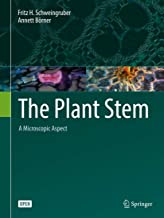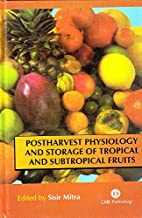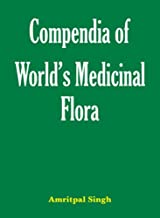The Plant Stem: A Microscopic Aspect
Original price was: ₹4,624.08.₹3,699.26Current price is: ₹3,699.26.
ISBN: 9783319735238
Author/Editor: Fritz H Schweingruber
Publisher: Springer
Year: 2018
1 in stock (can be backordered)
Description
This unique and attractive open access textbook combines the beauty of macroscopic pictures of plant stems with the corresponding colorfully stained images of anatomical micro-structures. In contrast to most botanical textbooks, it presents all the stem characteristics as photographs and shows the microscopic reality.
The amount of text is reduced to a minimum, and the scientific information is highlighted with short legends and labeled photographs, allowing readers to focus on the pictures to easily understand how the anatomical structures relate to genetic, ecological, decomposition and technical influences. It includes a chapter devoted to simple anatomical preparation techniques, and further chapters showing the cell content, cell walls, meristematic tissues and stem structures of all major taxonomic units and morphological growth forms in various ecological and climatic regions from subarctic to equatorial latitudes, as well as structures of fossil, subfossil and technically altered wood.
This textbook appeals to students and researchers in the fields of plant anatomy, taxonomy, ecology, dendrochronology, history, plant pathology, and evolutionary biology as well as to technologists.
Additional information
| Weight | 1.058 kg |
|---|
Product Properties
| Year of Publication | 2018 |
|---|---|
| Table of Contents | TABLE OF CONTENTS 1 Introduction 2 Preparation techniques - Making anatomical structures visible 3 Morphology of the plant body 3.1 Growth forms and life forms 3.2 Parts of stems and definition of bark terms 4 Cellular composition of the plant bodies 4.1 The individual cell 4.2 Meristematic initials - The source of new cells 4.3 The cuticula - Protection against dehydration 4.4 Epidermis - The skin of plants 4.5 Collenchyma - Local peripheral stability 4.6 Parenchyma cells - Storage and repair 4.7 Fibers and tracheids - Stabilization and water conduction 4.8 Sclereids in the bark - Aberrant cell wall thickening 4.9 Vessels - Water conductance 4.10 Cork cells - Defense against organisms, heat and cold 4.11 Sieve cells, sieve tubes and companion cells - Conduction of assimilates 4.12 Secretory cells - Defense 4.13 Intercellulars and aerenchyma - Air circulation within the plant 5 Structure of cell walls and cell contents 5.1 Principal cell wall construction - Form and stability 5.2 Pits - Lateral contact between cells 5.3 Perforation plates - Axial contact between vessels 5.4 Helical (spiral) thickenings - Special wall thickenings 5.5 Tyloses - Permanent interruption of water flow 5.6 Cell contents - Everything inside the cell wall 5.6.1 Nuclei in Protoplasts - Metabolic centers of the plant cells 5.6.2 Plastids - Green, yellow and white bodies 5.6.3 Starch grains - Stored energy 5.6.4 Crystals in vacuoles - Regulators and metabolic waste 5.6.5 Stained substances within the stem - Defense 6 Primary, secondary and tertiary meristem 6.1 Primary meristems in apical zones - Initials of longitudinal and radial growth 6.1.1 Macroscopic aspect of primary meristems in apical shoots and roots - Grow higher, grow deeper 6.1.2 Apical shoot dynamics - Long and short shoots - Grow fast, grow slow 6.1.3 Shoot death and metamorphosis - The end of longitudinal growth: Twigs must die 6.1.4 Microscopic aspect of apical meristems of shoots and roots - Towards heaven and earth 6.1.5 From the primary apical meristem to the secondary lateral meristems in shoots - From longitudinal to radial growth 6.1.6 From the primary apical meristem to the secondary lateral meristems in roots - From longitudinal to radial growth 6.1.7 From the primary apical meristem in shoots to roots in plants without cambium (monocotyledons) 6.1.8 From the primary apical meristem of vascular spore plants in shoots to roots 6.1.9 Pericycle and endodermis - Central cylinder and cortex are separated 6.2 Secondary and tertiary meristems and radial growth - Cambium and cork cambium 6.2.1 Macroscopic aspect of radial growth and xylem coloration - Stems get thicker 6.2.2 Microscopic aspect of radial growth (conifers, dicotyledonous plants and palm ferns) - An overview 6.2.3 The production and enlargement of new cells in the xylem of a thickening stem - The need of more and larger cells 6.2.4 Cell formation and differentiation in the xylem - The multifunctional stem center 6.2.5 Timing of xylem formation 6.2.6 Cell differentiation in the phloem - The multifunctional stem periphery 6.2.7 Formation of tertiary meristems, the cork cambium - A new skin 6.2.8 Life time and death of cells - Cells must die 6.3 Cambial variants - Phloem elements within the xylem 6.4 Intercalary meristems - Longitudinal growth far behind the tips of shoots and roots 7 Stem anatomical structures of major taxonomic units 7.1 Stem-forming fungi and algae 7.1.1 Sporophytes of fungi 7.1.2 Thallus and stems of brown algae 7.2 Mosses - The oldest living plants 7.3 Fern-like plants 7.3.1 Spikemosses, quillworts and clubmosses 7.3.2 Whisk fern and moonwort 7.3.3 Horsetails 7.3.4 Ferns 7.4 Seed plants 7.4.1 Palm ferns 7.4.2 Ginkgo 7.4.3 Conifers 7.4.4 Gnetales Ephedraceae Welwitschiaceae Gnetaceae Gnetales: Conifers or Angiosperms? 7.4.5 Angiosperms - Monocotyledons and their growth forms Palms (Arecaceae) Bamboo (Poaceae) Grass-like terrestrial herbs (Cyperaceae) Terrestrial grasses (Poaceae) Orchids (Orchidaceae) Lianas Hydrophytes Trees and shrubs with secondary growth (Dracaena, Aloe) 7.4.5 Angiosperms - Dicotyledons and their growth forms Annual herbs (therophytes) Perennial herbs (hemicryptophytes and geophytes) Dwarf shrubs (chamaephytes and nanophanerophyte) Shrubs (nanophanerophytes) Trees (phanerophytes) Lianas Succulents Parasites Hydrophytes and helophytes 8 Evolution of stems 8.1 Paleobotanic evidences of stems Early plant evolution The move to the land The earliest small land plants The earliest trees The Carboniferous clubmoss and horsetail forests (Lycophyta and the Sphenophytes) The first gymnosperms (Cordaitales) The development of Angiosperms 8.2 Evolution and homoplasy of wood anatomical traits Homoplasy and evolution 8.3 Parallel evolution of macroscopic and microscopic traits 8.3.1 Mesic European fir forest (Adenostylo-Abietetum) 8.3.2 Heathlands along European North Atlantic coast 8.3.3 Alpine meadows (Caricetum curvulae) 9 Anatomical adaptions to permanent changed environmental conditions 9.1 Anatomical and morphological plasticity of species 9.2 Anatomical and morphological adaption to different climates 9.2.1 Trees in the tropics, the temperate and boreal zone Tropical rain forest Temperate forest Boreal forest 9.2.2 Shrubs in the tropics, the Mediterranean and arctic zone Subtropical African dry climate, Sahara European thermo-Mediterranean zone Arctic zone 10 Anatomical adaptions to temporarily changed environmental conditions 10.1 Anatomical effect of short-term environmental changes during the vegetation period 10.1.1 Individual small and large annual rings and missing rings 10.1.2 Discontinuous growth - Wedging rings 10.1.3 Individual small and large latewood zones and latewood zones with thin- or thick-walled tracheids 10.1.4 Individual, not fully lignified latewood zones ("blue rings") 10.1.5 False rings and density variations 10.1.6 Tissue and fiber cracks 10.2 Effect of multi-annual environmental changes 10.2.1 Abrupt growth changes 10.2.2 Structural changes 10.3 Eccentricity and irregular stem forms 10.4 Reaction wood - Reaction to mechanical stress 10.4.1 Compression wood in conifers 10.4.2 Tension wood in angiosperms 10.5 Cell collapse and lateral ray compression 10.6 Cambial wounding - Callus formation, overgrowing of wounds 10.7 Prevention of wounds 10.8 Resin and gum ducts 11 Coexistence of algae, fungi and vascular plants 11.1 Mycorrhiza - 11.2 Lichens - Coexistence of algae and fungi 12 Wood decay 12.1 Abiotic decomposition 12.2 Anaerobic decay - Absence of oxygen 12.3 Aerobic decay - Wood-decaying fungi 12.4 Compartimentalization - The natural limit to fungal growth 12.5 Decay by xylobiontic insects 13 Fossilization, permineralization, coalification, carbonization and wetwood conservation 13.1 Fossilization 13.2 Permineralization of archeological artefacts 13.3 Coalification 13.4 Carbonization |
| Author | Fritz H Schweingruber |
| ISBN/ISSN | 9783319735238 |
| Binding | Hardback |
| Edition | 1 |
| Publisher | Springer |
You must be logged in to post a review.






Reviews
There are no reviews yet.